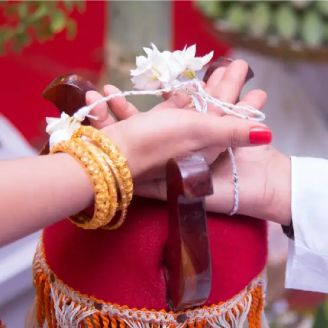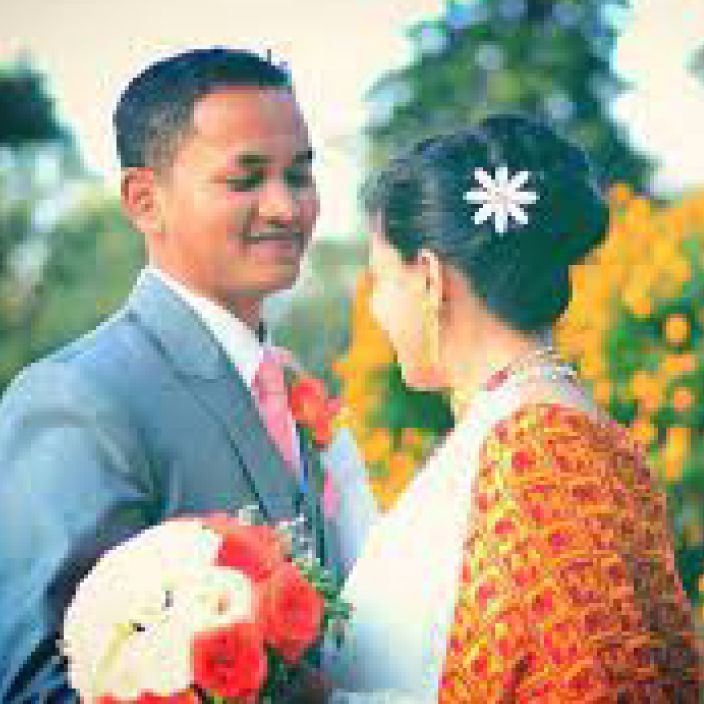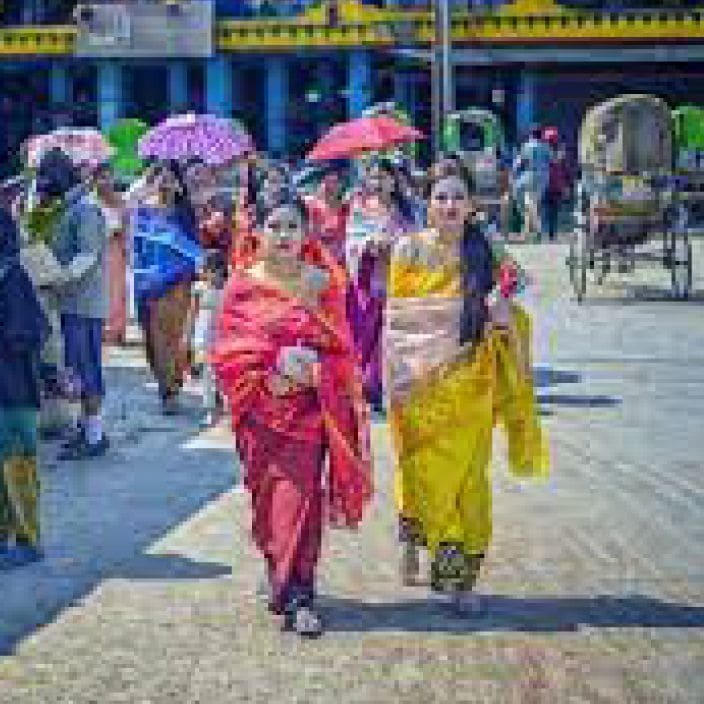For best prices and early deliveries, WhatsApp us at. 918488070070
Manipur
Manipur, in the northwestern region of India, is a state known for its diverse culture and customs. Surrounded by greenery and rolling hills, this picturesque state is mainly home to the Meitei community, which practices Hinduism and an indigenous faith called Sanamahism. The Meitei marriage traditions, known as Luhongba or Yum Paanba, have evolved over the centuries by incorporating elements from Hindu and indigenous beliefs. Manipuri weddings are affairs that showcase the longstanding customs of the Meitei people. These ceremonies are celebrated by the entire community with rituals, music, dance, and delicious feasts.
Tracing the Traditions
Similar to Indian wedding ceremonies, Manipuri weddings kick off with a series of pre-wedding rituals that set the stage for the grand festivities ahead. There are two types of marriages in Manipur: love marriages and arranged marriages.
In a love marriage scenario, male members from the groom’s family visit the bride’s family to announce that their son has chosen their daughter as his partner. This formal exchange marks the beginning of their union, after which the bride is escorted to her home with her husband. That evening, she goes out with the women from the groom’s family, symbolising her welcome into the new family.
In traditional arranged marriages, the groom’s family makes three visits to the bride's family before setting a date. During these visits, the families discuss various arrangements, including gifts for the Pala, the woman who sings Kirtans at the wedding. The first formal meeting is called Hinaba, where the groom’s family visits the bride’s house to match the horoscopes and discuss the potential union. Once the families agree, they promise to meet again at a later date.
This is followed by the Yathang Thanaga ceremony, during which the bride’s family formally consents to the marriage. The groom’s family reciprocates this gesture in the Waraipot Puba ceremony by exchanging gifts and food items. The engagement ceremony called Hejiapot is interesting because it happens without the couple meeting; instead, the groom’s family brings gifts like jewellery, clothes and engagement rings to announce the wedding date through a priest.
Traditional customs such as Bor Baton and Leilenga are observed on the wedding day. A young boy from the groom’s family formally invites the groom to the ceremony while the bride carefully weaves two garlands using Kundo flowers.
The primary wedding ritual, Luhongba, happens at the bride's residence. The groom's family is warmly welcomed with betel leaves and nuts, and the wedding altar is adorned with a tulsi plant. The groom sits alongside the priest as they await the bride's arrival. During this ceremony, the bride's mother ties a thread around their hands while offering blessings with a plate containing coconut, banana, betel leaf, and nut. Following this gesture, the bride circles around the groom seven times to cement their marriage before exchanging garlands.
Afterwards, post-wedding traditions include receiving blessings from relatives and participating in the Vidaai ritual, where the bride bids farewell to her family. At her home, with her husband’s family, her uncle conducts a special ceremony known as Phamnando to wish for a life ahead. The elders bless her while she sits on a bed before enjoying a meal or reception together.
Five days later, a traditional ceremony known as Mangani Chakouba takes place at the bride's home, where a grand feast is arranged for family and friends.
Wedding Attire
In Meitei weddings, the bride's outfit is intricate and unique. She usually wears a Phanek, a Meitei sarong along with a Kajenglei, a headdress. However, during Meitei Hindu weddings, brides opt for a Potloi. The Potloi is a skirt crafted from satin fabric and bamboo embellished with embroidery, mirrors, and shimmering accents. This attire also includes a blouse, a belt around the waist, an Innaphi, and an elegant muslin shawl draped over the body. To complete the look, brides often wear a Kajenglei headdress made of brass strips fastened to red flannel ribbons.
Introduced by Maharaja Bhagyachandra in the 18th century, the Potloi was first worn by Gopis in the Rasa Leela dance before gaining popularity among Hindu Meitei brides for their nuptials. One intriguing aspect of the Potloi is that it is tailored onto the bride an hour or two before the wedding ceremony to ensure a snug fit.
In contrast to the bride’s attire, the groom’s clothing is relatively simple. He usually dresses in a dhoti and kurta set. The dhoti, a piece of cloth often white or cream in colour, represents purity and simplicity. It is wrapped around the waist and legs in a traditional style. Along with the dhoti and kurta, the groom wears a turban as a sign of respect and honour. To complete his look, he may wear a wristwatch and traditional footwear such as Kolhapuri or Jodhpuri sandals.
Jewellery plays a huge role in enhancing the Manipuri bride’s appearance. Manipuri brides favour gold jewellery adorned with pearls and stones. They wear long layered necklaces called Likhom along with ornate earrings, gold bangles, and rings to complement their dress. Traditional Manipuri jewellery includes Kiyang Likphang, Marei Parang, Khimarun, Likchow, Kantha, and Khownappi — each piece is distinctively beautiful. Other notable jewellery items include the Maatha Patti or mang tikka – a headpiece that rests on her forehead.
Traditional Cuisine
The cuisine of Manipur, a state known for its fishing traditions, is deeply rooted in local influences. Rice serves as a staple and is typically accompanied by an array of meat, fish and vegetable dishes. Emphasising the use of sourced ingredients like fish, vegetables, herbs and spices, Manipuri cuisine is celebrated for its nourishing qualities. Fish sourced from the region's rivers and lakes plays a central role in preparing dishes through smoking, drying, or cooking with various seasonings.
Some popular Manipuri delicacies include Chamthong (a vegetable stew), Chak hao kheer (a dessert made with rice), Ngari (fermented fish), and Iromba (a blend of boiled vegetables with fish and mashed chillies). The cuisine tends to be flavoured rather than excessively spicy, featuring a harmonious mix of ginger, garlic, and chilli peppers. Additionally, fermented foods, like fish and vegetables, are commonly incorporated into dishes to give them a signature tanginess.
In a Manipuri meal, you can expect to enjoy a vegetable stew known as ensaang or athongba, which is seasoned with dried or fried fish. Alongside this are stir-fried vegetables called kanghou and a spicy dish like morok metpa or eromba (mashed vegetables with chilli and fermented fish). These side dishes are served with herbs collectively known as maroi.
During a Manipuri wedding celebration, guests are treated to a variety of appetisers, main courses, desserts, and drinks. Appetisers may include pakoras and singju, a type of salad. The main course typically features rice paired with ooti (curry made from green/yellow peas, chives and beans) and Nga Atoiba Thongba (fish curry). For dessert, Chak hao kheer, a pudding made from rice, is often served. To complete the feast, traditional beverages like tea, rice, and beer are offered.
Cultural Decor
The decor at Manipuri weddings beautifully combines Indigenous elements with contemporary aesthetics. The entrance to a wedding location is usually striking, featuring bamboo arches adorned with blooms like marigolds and other local flowers. These floral displays infuse natural beauty and fragrance into the festivities. The pathway leading to the wedding altar is often strewn with flower petals, creating a beautiful route for the bride and groom.
The wedding altar itself holds a focal importance in Manipuri wedding decorations. It is often embellished with wood and stone carvings that showcase the region's craftsmanship. Colourful block-printed fabrics are used to adorn the altar, introducing hues and textures. These fabrics often showcase designs that enhance the religious essence of the setting.
Inside the venue, silk and cotton drapes hang from ceilings and walls. These textiles, typically handcrafted using dyes, highlight the skills of Manipuri weavers. Textile weaving, locally referred to as Laichamphi, holds a special place in the heart of Manipur, where skilled women create fabrics for various decorative purposes.
The wedding decor showcases the state's handloom and handicraft products, which are globally recognised for their designs, vibrant colours, and practicality. Bamboo craftsmanship is quite popular, with various items like mats, baskets, and flower holders contributing a sophisticated vibe to the overall decoration. The art of flower arrangements is pivotal in enhancing the ambience, as marigolds, roses, and other Indigenous flowers are artfully woven into garlands, bouquets, and centrepieces. Beyond their aesthetic charm, these floral displays stand for purity, affection, and prosperity.
Unique embellishments like papier mâché ornaments, ivory pieces, and traditional dance figurines add a flair to wedding decorations. Handcrafted by artisans with rooted artistic traditions, these items infuse the celebration with a rich tapestry of heritage and craftsmanship. Additionally pottery sourced from tribes like Andro, Thongjao and Nungbi—renowned for their expert handiwork sans a potter’s wheel—holds significance in adorning the decor. These finely crafted pots and vessels serve as integral components in wedding rites.
Kauna reeds found in local terrains are devised into cushioning materials and mats for wedding seating arrangements. These crafted artefacts not only offer comfort but also elevate the visual allure of seating areas. In Manipur, block printing is a craft that creates hand-printed towels, clothing, and ceremonial items. These textiles are commonly used as table decorations and chair covers.


